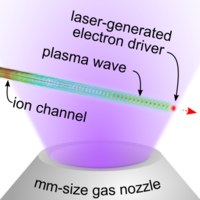Abstract
Plasma wakefield acceleration (PWFA) is a novel acceleration technique with promising prospects for both particle colliders and light sources. However, PWFA research has so far been limited to a few large-scale accelerator facilities worldwide. Here, we present first results on plasma wakefield generation using electron beams accelerated with a 100-TW-class Ti:sapphire laser. Because of their ultrashort duration and high charge density, the laser-accelerated electron bunches are suitable to drive plasma waves at electron densities in the order of . We capture the beam-induced plasma dynamics with femtosecond resolution using few-cycle optical probing and, in addition to the plasma wave itself, we observe a distinctive transverse ion motion in its trail. This previously unobserved phenomenon can be explained by the ponderomotive force of the plasma wave acting on the ions, resulting in a modulation of the plasma density over many picoseconds. Because of the scaling laws of plasma wakefield generation, results obtained at high plasma density using high-current laser-accelerated electron beams can be readily scaled to low-density systems. Laser-driven PWFA experiments can thus act as miniature models for their larger, conventional counterparts. Furthermore, our results pave the way towards a novel generation of laser-driven PWFA, which can potentially provide ultralow emittance beams within a compact setup.
- Received 26 October 2018
DOI:https://doi.org/10.1103/PhysRevX.9.011046
Published by the American Physical Society under the terms of the Creative Commons Attribution 4.0 International license. Further distribution of this work must maintain attribution to the author(s) and the published article’s title, journal citation, and DOI.
Published by the American Physical Society
Physics Subject Headings (PhySH)
Collections
This article appears in the following collection:

Special Collection on Laser-Plasma Particle Acceleration
Physical Review X showcases the scientific vitality and diversity of the field of laser-plasma particle acceleration with a carefully curated collection of articles.
Popular Summary
By smashing together particles at very high speeds, physicists have identified the fundamental ingredients of the Universe—particles and forces—and how they interact. But researchers suspect that there are more waiting to be found, and those discoveries will require particle colliders that operate at much higher energies than current facilities. However, such colliders will eventually become too expensive to build because achieving those energies will require accelerating particles across spans reaching hundreds of kilometers. Hence, alternative approaches have been proposed to reach those energies in a fraction of the space. We present a successful demonstration of one of the most promising of those approaches, known as beam-driven plasma wakefield acceleration (PWFA), on a laboratory scale.
Conceived in the 1980s, PWFA relies on an intense particle beam to generate a relativistic plasma wave. PWFA can impart a 40-GeV energy gain within less than a meter; the same gain that conventional accelerators impart over several kilometers. Until now, large-scale accelerators, which are sparsely available, have been necessary to study PWFA.
We present, for the first time, beam-driven plasma wakefield generation on a laboratory scale. Our laser-generated electron beams can drive plasma waves at unprecedentedly high densities, producing a “miniature model” of large-scale PWFAs. Furthermore, the all-optical setup enables us to study the femtosecond-to-picosecond dynamics of the plasma. This reveals a theoretically predicted, but yet unobserved, plasma response in the trail of the wave, which is highly relevant for the development of efficient PWFAs.
Our measurements show that widely available laser systems are a viable addition to the study of the physics of plasma wakefield acceleration, one that will boost research on PWFA and future high-energy colliders.



